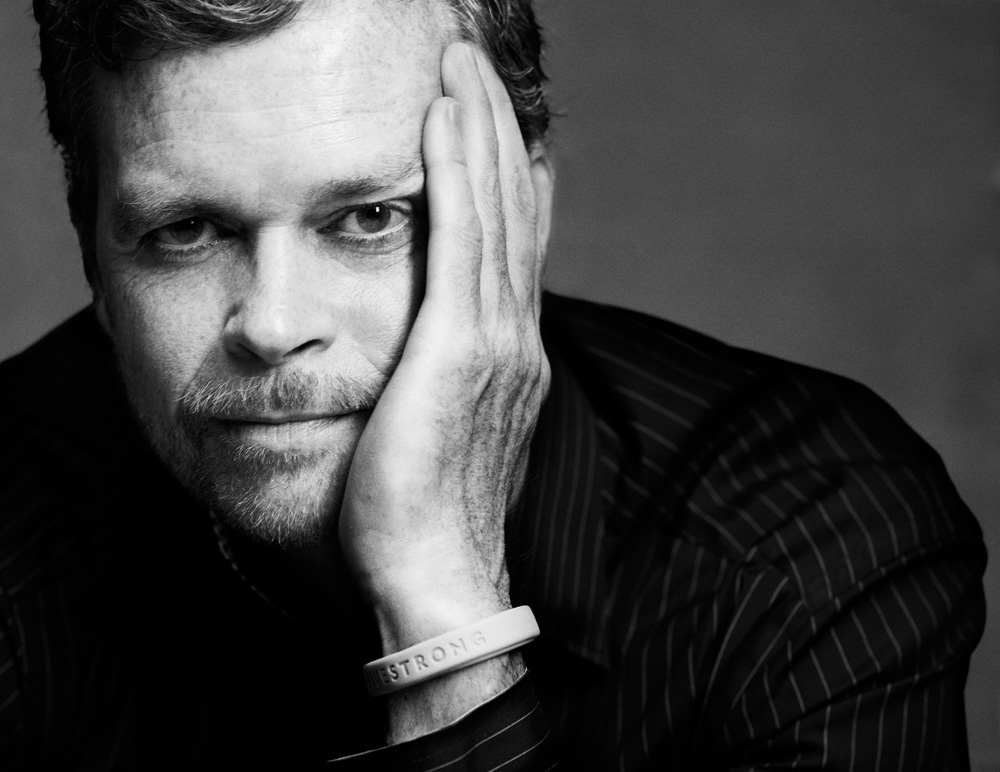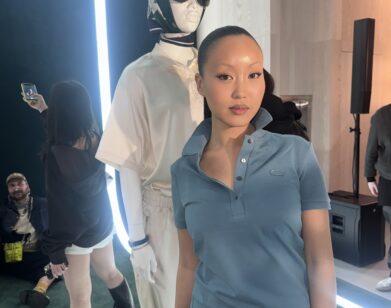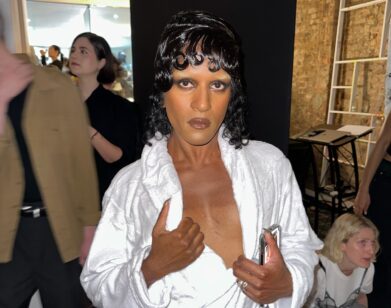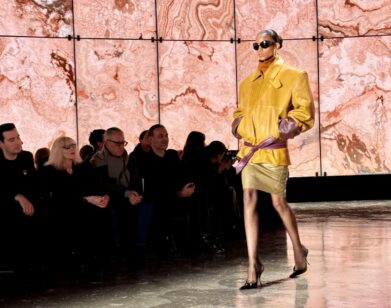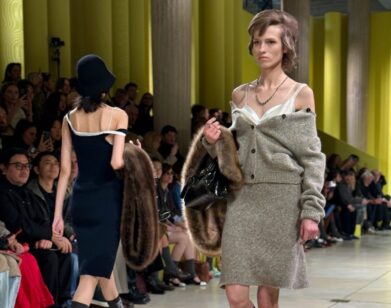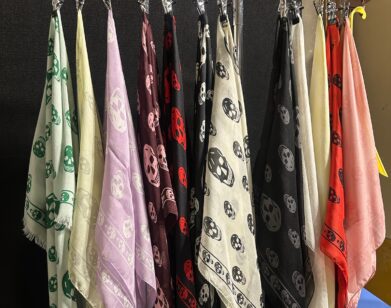Mark Parker
In his three decades at Nike, CEO and president Mark Parker has worked with a number of athletic and cultural gods, from Michael Jordan (Parker was heavily involved in the design of the Air Jordan) to Ken Kesey (whom he once consulted on the design of a wrestling shoe). He also collaborated with Lance Armstrong five years ago to create the now-iconic yellow LIVESTRONG wristband to raise cancer awareness after the cyclist’s bout with testicular cancer. This year, Parker has reteamed with Armstrong to spearhead a project called STAGES, a traveling art exhibition. Parker and Armstrong, both avid art fans, co-curated the show, recruiting more than 20 artists—among them, Richard Prince, Ed Ruscha, Aaron Young, Andreas Gursky, Raymond Pettibon, and Catherine Opie—to create original works, the sales of which will benefit the Lance Armstrong Foundation.
Unveiled during a one-week engagement at Galerie Emmanuel Perrotin in Paris in July, STAGES opens in New York in October. Artist Tom Sachs, who assembled a bike that includes a tequila bar for the show, recently met up with Parker to dis¬cuss the exhibition and talk about why, contrary to conventional high school wisdom, athletes and art¬ists really can be friends.
TOM SACHS: You have put together a group of artists for STAGES whose work you support and who, like athletes, are deeply committed to their craft, their obsession. Tell us about the connection between these artists and the athletes you work with.
MARK PARKER: I’m drawn to people who are obsessed, and I guess people who know me have described me that way—a little otaku. I’ve been fortu¬nate in my work at Nike, whether it’s through design or even the role I’m in now, to connect very closely with some of the top athletes in the world. Many of those athletes share that obsessive drive. I’ve seen it in Michael Jordan and Tiger Woods, and I see it in Lance. We actually worked out together down in Austin, Texas, where Lance lives. It was a challenge—I dialed it back a bit so he could keep up. [laughs] But it’s that incredible drive and almost single-minded¬ness that is really impressive. And obviously it doesn’t have to just be in sports. It’s in science and art and music and filmmaking—everywhere. That’s the con¬nection. I think the artists in the STAGES exhibition all share that passion for what they do.
SACHS: How did STAGES get off the ground?
PARKER: We were visiting with Lance in Austin last year after he announced he was returning to compet¬itive cycling and the Tour de France. Afew of us were hanging out at his house, kicking around ideas about what we could do to use Lance’s comeback to help in the fight against cancer. One of the things Lance and Ishare is an interest in art. We both commission art, collect art, and support creative people, so it was a very natural thing for us to land on the idea of combining sports and art in the interest of philanthropy.
SACHS: Why is it called STAGES?
PARKER: It refers to two things: the stages of cancer’s progression, and the 21 stages of the Tour de France.
SACHS: You’ve been with Nike for 30 years. You started as a product designer and have done a lot of different things on your way to becoming CEO. And yet you’re still a designer. In fact, you’re a bit notorious for always sketching while you’re in meetings.
PARKER: True, all true. I’m a relentless sketcher. It goes back to how you process the world around you—the whole left-brain, right-brain thing. Some people are data-driven. I’ve always been more visual. Generally speaking, Ithink designers are often undervalued and underappreciated. I guess you could argue that that’s okay because there is some merit to the idea that the best design is invisible design. At Nike specifically, we try to keep it simple. It’s impor¬tant to avoid any ancillary noise that doesn’t add to the design. Basically, get rid of the clutter—nothing gratuitous. I think overdesigning comes from a lack of editing. The strongest, most compelling, and most useful things in life are irreducible—love, truth, faith, honor. Some people want a product with a very overt aesthetic, and I think there’s a place for products all along that spectrum. But our company was founded on connecting with the athlete in a really deep way. One of the co-founders of Nike, Bill Bowerman, was this eccentric obsessive-inventor type. He was always looking for better ways to make equipment that helps the athletes perform at their highest level. Before I came to Nike I was already modifying my shoes to help me run better so it was natural for me to look at how I could make the shoes better from a purely utilitarian perspective, which is really what Bill Bowerman was doing.
SACHS: I heard that you once hung out with the writer Ken Kesey.
PARKER: Yeah. What a day. I was very young, just starting out, and one of my assignments was to go and spend a day with Ken at his place outside of Eugene, Oregon. Absolutely beautiful countryside. Kesey meets me at the airport and we drive to his place after stopping at Nancy’s Yogurt Factory, which his brother was running at the time. Everybody working there looked like they’d walked in off a commune. It was a very earthy, hippie crowd. It was great to spend a day with Ken. After I met his family, we walked back to the little shed where he wrote his books, and Ken pulled out some weed and we sat there and talked about a wrestling-shoe design for a few hours. He went on and on about what he thought we could do to make better wrestling shoes. Ken was a great wrestler in his college days at University of Oregon. Wrestling ran deep in the family. His son was a wrestler at the time, competing at the collegiate level, and they would wrestle together. Their living room floor was a wres¬tling mat. They’d just shove the furniture aside and go at it, father and son.
SACHS: What’s it like collaborating with athletes? How much of the creative process is driven by the designer and how much is driven by the athlete?
PARKER: I love working with athletes. They’re all very demanding. Michael Jordan wasn’t just con¬cerned with something that was going to perform really well—he wanted a shoe that had a certain aesthetic. When an athlete puts on a pair of shoes to compete in, they want to feel like they’ve got the best weapon. Part of that is function, but it’s also about style—a color combination, the way the lines move around the foot and the shoe to make them feel faster. The psychology of performance in athletic footwear and apparel is very real. Most athletes do not say, “Just give me what works the best—I don’t care what it looks like.” They’re very concerned with what it looks like and how it makes them feel. I remember when Jordan was a rookie and we had the Air Jordan 1 shoe. He was fined for wearing it because it fell outside the NBA guidelines and rules in terms of color. We gladly paid the fine—I think it was $5,000 per game—and got lots of attention. It sort of put the spotlight on the shoes, and it worked out really well. I was designing and developing at that time. I took that Air Jordan 1 and tweaked it while I was over working with a fac¬tory in Korea. I picked out some sample materials that I thought would make a cool version of that shoe—black patent leather, gold stitching, sort of pimped it out—just a little side project. MJ saw it and loved it, so we made five pairs just for fun and gave them out to friends. Not long ago, a pair showed up at auction in Tokyo and sold for something like $80,000.
SACHS: Where did this sneaker culture begin?
PARKER: Actually, I think the origins of sneakerhead culture were back in Eugene, Oregon, on the track. In our early years as designers we would make the popular shoes in the most bizarre color schemes simply because we could. It was fun and outrageous and there was nothing better than to hear, “Where the hell did you get that?” Then along came the Air Force 1 and the Air Jordan and pushed sneaker culture to a whole new level. We started doing new designs of classic shoes—Air Force 1, Dunks, Cortez, Bruins, Waffle Trainers. Pretty soon we were collaborating with artists, and that whole thing took off.
SACHS: Now you also have NIKEiD. I always tell people it’s a great way to spend an hour and $100, because you can create this incredible work of art. I have a pair that my friend made, which he called the Air Geertgen because Geertgen is his favorite old-master painter.
PARKER: People have always wanted to express themselves, especially when it comes to things they put on their body. So we’re very involved in creating new ways for people to do that. I think customiza¬tion is going to get more and more advanced. Initially there was some concern that there would be some awful-looking shoes out there.
SACHS: There is a game that we play with NIKEiD which is to make the shoe as ugly as you can. I think everyone has done that.
PARKER: Yeah, we do that on occasion at Nike. But I can’t say it’s always a joke.
Tom Sachs is a New York City–based artist. He recently exhibited camera-based artworks at the Aldrich Contemporary Art Museum in Ridgefield, Connecticut.

